Changes in PRIMAP-hist v2.6.1_final compared to v2.6_final for Finland
2025-03-19
Johannes Gütschow
Change analysis for Finland for PRIMAP-hist v2.6.1_final compared to v2.6_final
Overview over emissions by sector and gas
The following figures show the aggregate national total emissions excluding LULUCF AR6GWP100 for the country reported priority scenario. The dotted linesshow the v2.6_final data.
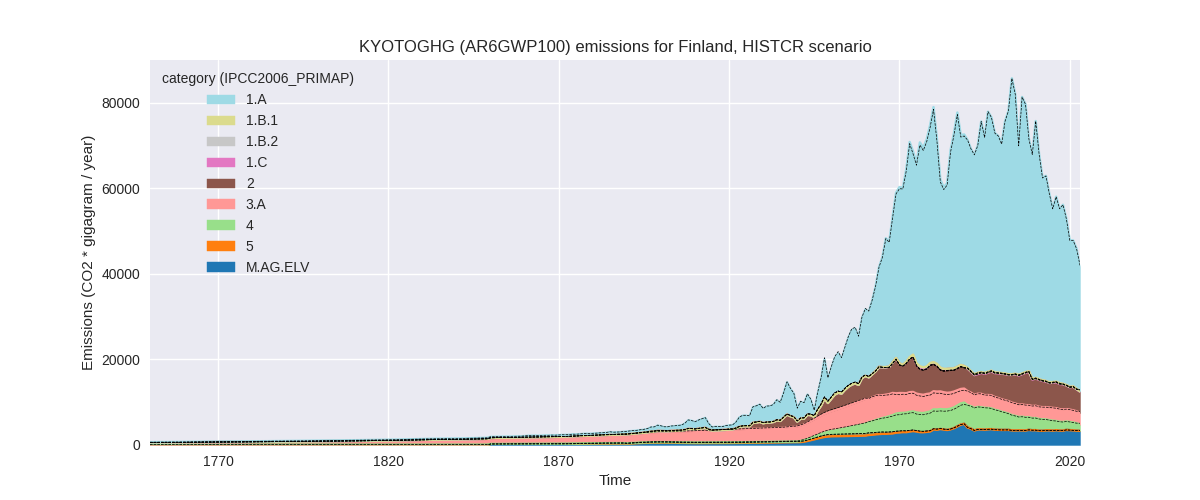
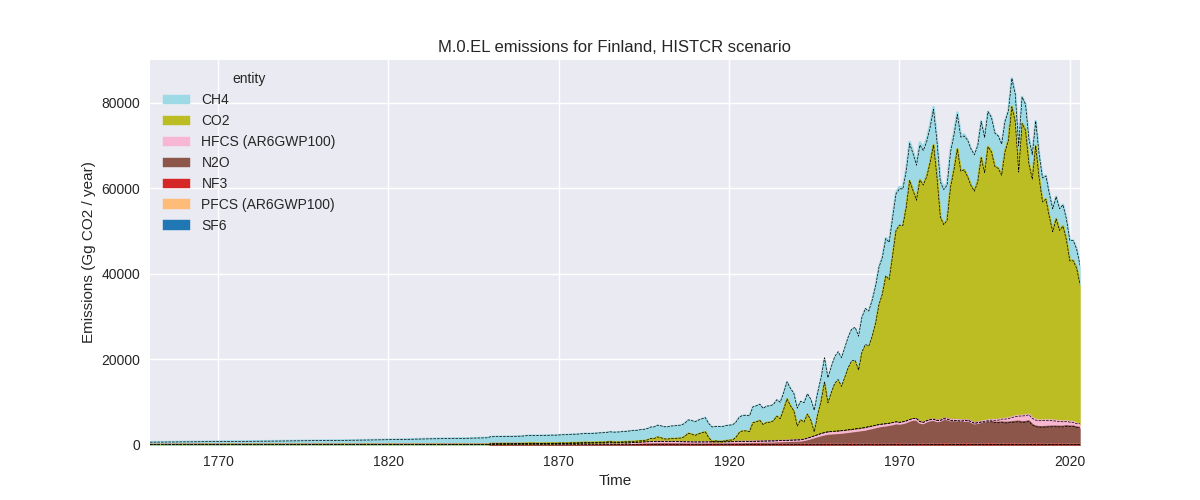
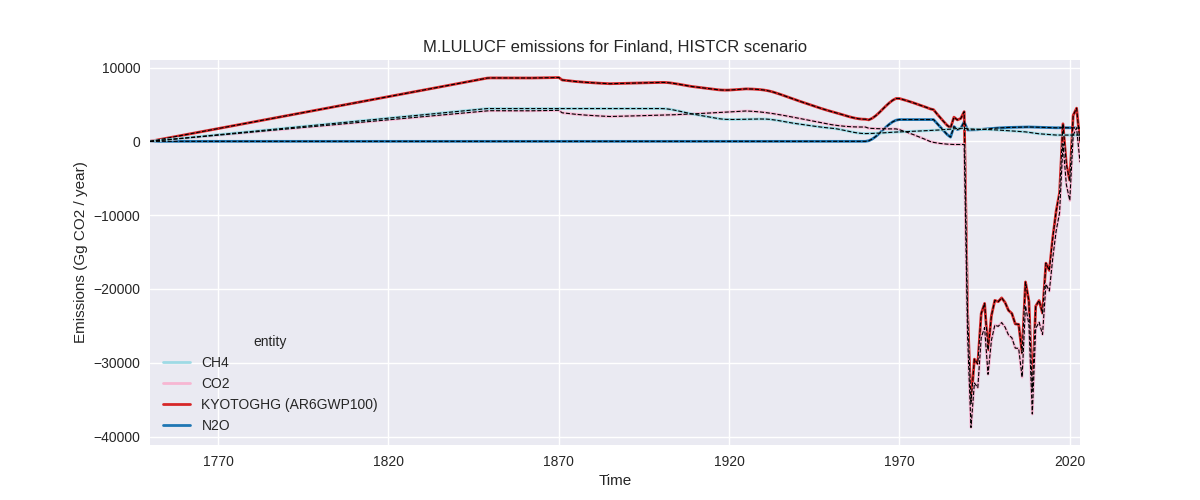
The following figures show the aggregate national total emissions excluding LULUCF AR6GWP100 for the third party priority scenario. The dotted linesshow the v2.6_final data.
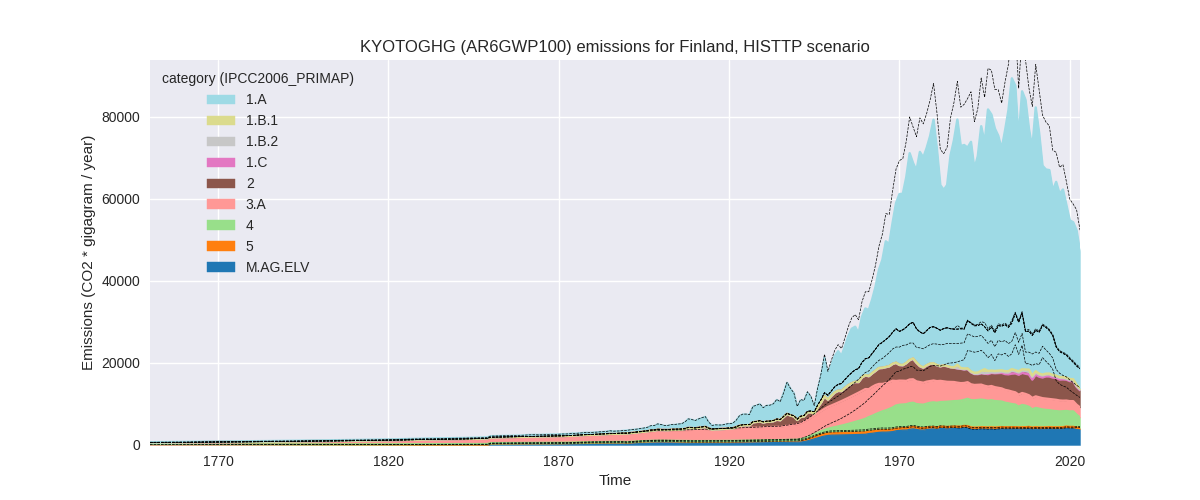
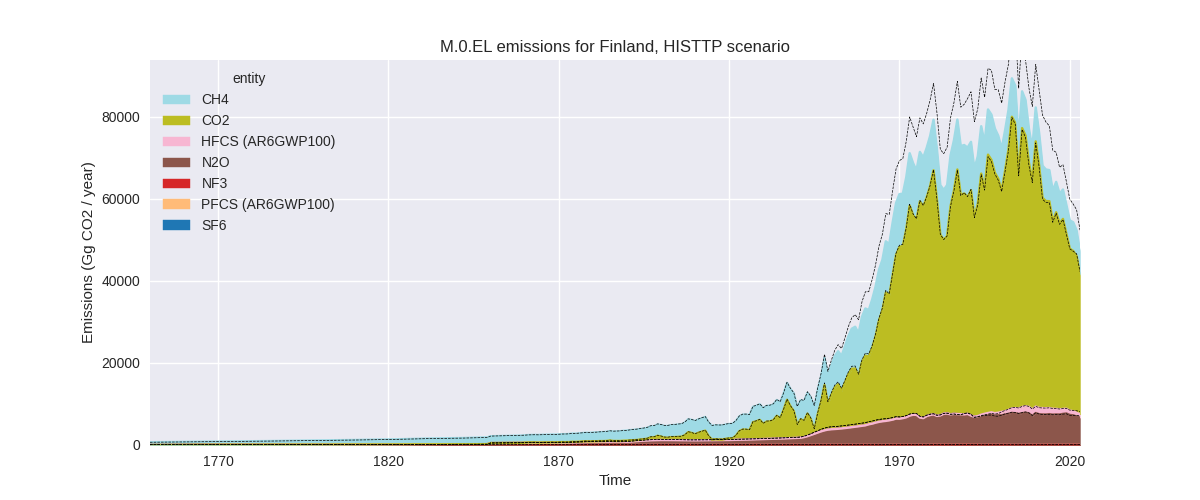
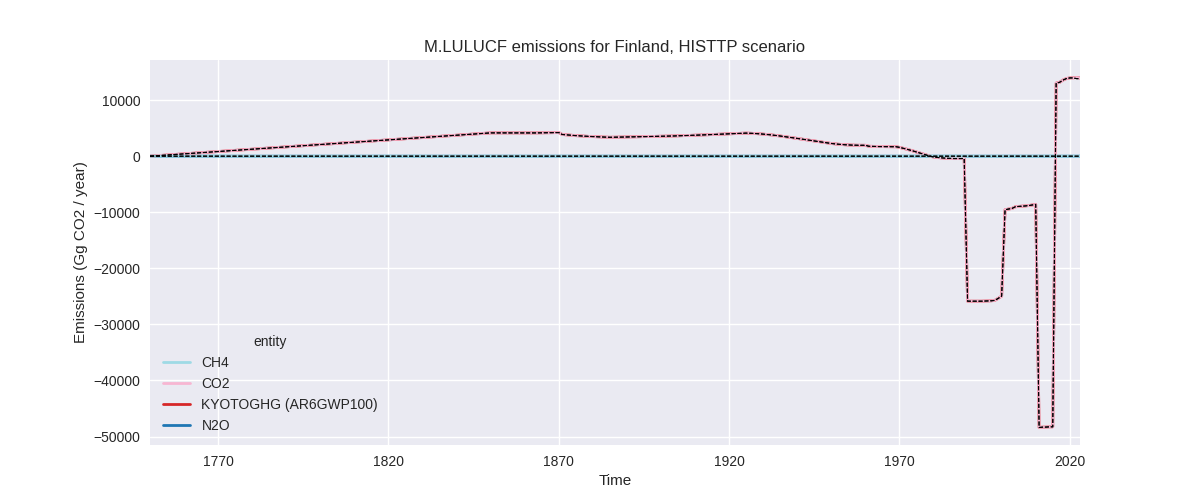
Overview over changes
In the country reported priority scenario we have the following changes for aggregate Kyoto GHG and national total emissions excluding LULUCF (M.0.EL):
- Emissions in 2023 have changed by -1.0%% (-426.82 Gg CO2 / year)
- Emissions in 1990-2023 have changed by 0.0%% (3.94 Gg CO2 / year)
In the third party priority scenario we have the following changes for aggregate Kyoto GHG and national total emissions excluding LULUCF (M.0.EL):
- Emissions in 2023 have changed by -9.9%% (-5204.02 Gg CO2 / year)
- Emissions in 1990-2023 have changed by -12.3%% (-9992.59 Gg CO2 / year)
Most important changes per scenario and time frame
In the country reported priority scenario the following sector-gas combinations have the highest absolute impact on national total KyotoGHG (AR6GWP100) emissions in 2023 (top 5):
- 1: 4, CH4 with -260.17 Gg CO2 / year (-16.5%)
- 2: M.AG.ELV, N2O with -101.22 Gg CO2 / year (-3.2%)
- 3: 1.A, N2O with -46.86 Gg CO2 / year (-9.7%)
- 4: 2, N2O with -40.08 Gg CO2 / year (-19.6%)
- 5: 3.A, CH4 with 16.20 Gg CO2 / year (0.6%)
In the country reported priority scenario the following sector-gas combinations have the highest absolute impact on national total KyotoGHG (AR6GWP100) emissions in 1990-2023 (top 5):
- 1: 2, HFCS (AR6GWP100) with 16.64 Gg CO2 / year (1.8%)
- 2: 4, CH4 with -7.65 Gg CO2 / year (-0.2%)
- 3: M.AG.ELV, N2O with -2.98 Gg CO2 / year (-0.1%)
- 4: 1.A, N2O with -1.38 Gg CO2 / year (-0.3%)
- 5: 2, N2O with -1.18 Gg CO2 / year (-0.1%)
In the third party priority scenario the following sector-gas combinations have the highest absolute impact on national total KyotoGHG (AR6GWP100) emissions in 2023 (top 5):
- 1: 4, CH4 with -4546.70 Gg CO2 / year (-65.6%)
- 2: M.AG.ELV, N2O with -334.07 Gg CO2 / year (-7.9%)
- 3: 2, HFCS (AR6GWP100) with -225.99 Gg CO2 / year (-21.1%)
- 4: 2, CO2 with -109.95 Gg CO2 / year (-4.7%)
- 5: 1.A, N2O with -104.50 Gg CO2 / year (-9.1%)
In the third party priority scenario the following sector-gas combinations have the highest absolute impact on national total KyotoGHG (AR6GWP100) emissions in 1990-2023 (top 5):
- 1: 4, CH4 with -10204.99 Gg CO2 / year (-67.1%)
- 2: 1.B.2, CO2 with 266.66 Gg CO2 / year (2467.4%)
- 3: 2, HFCS (AR6GWP100) with -50.20 Gg CO2 / year (-5.0%)
- 4: 1.A, N2O with -17.07 Gg CO2 / year (-1.1%)
- 5: 2, SF6 with 11.37 Gg CO2 / year (73.2%)
Notes on data changes
Here we list notes explaining important emissions changes for the country.
- CRT data has been included but replaces official data reported to the EU which does not show noteworthy differences. Changes in the CR time-series are small and come from updated third party data (EDGAR, FAO) which is used to extrapolate the country reported data.
- Changes in the TP time-series are dominated by a 65% reduction in Waste CH4 in new EDGAR data. Smaller influences in other sectors also come from new EDGAR and FAO data. FAO data changes are limited to the latest years.
Changes by sector and gas
For each scenario and time frame the changes are displayed for all individual sectors and all individual gases. In the sector plot we use aggregate Kyoto GHGs in AR6GWP100. In the gas plot we usenational total emissions without LULUCF.
country reported scenario
2023
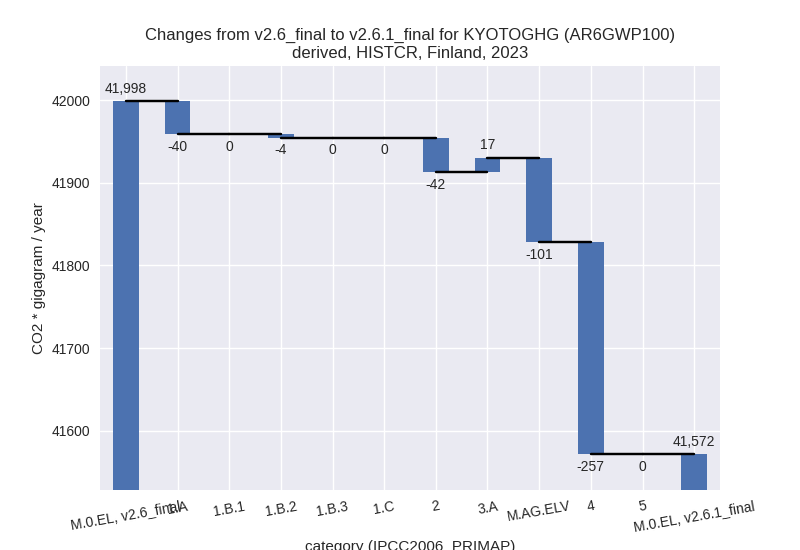
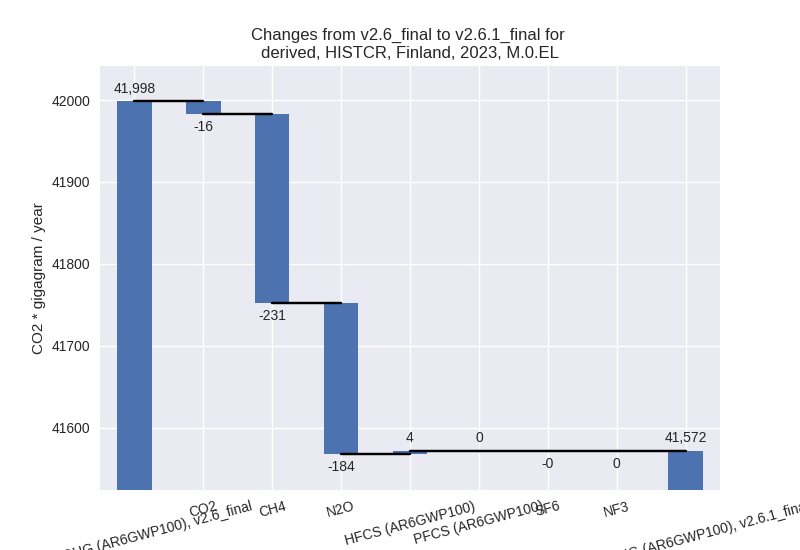
1990-2023
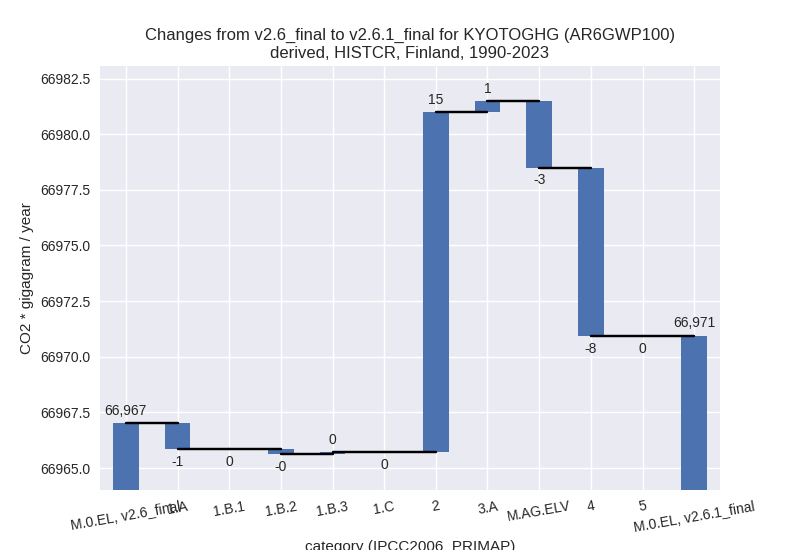
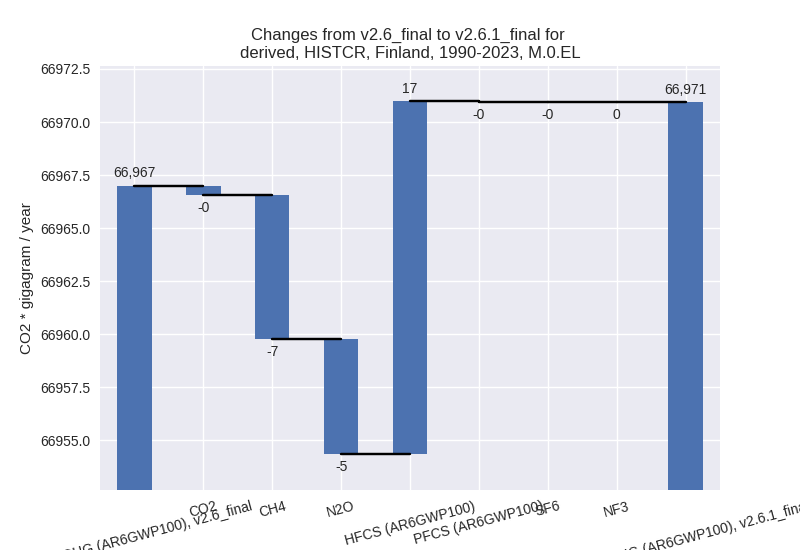
third party scenario
2023
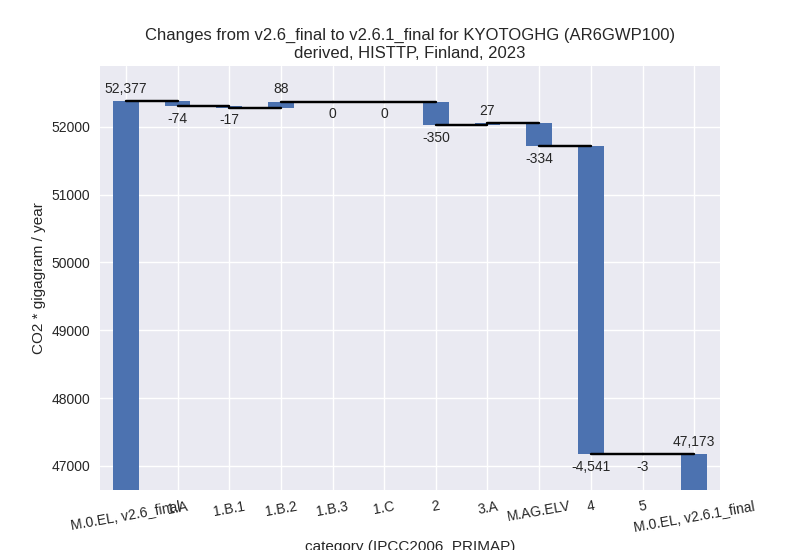
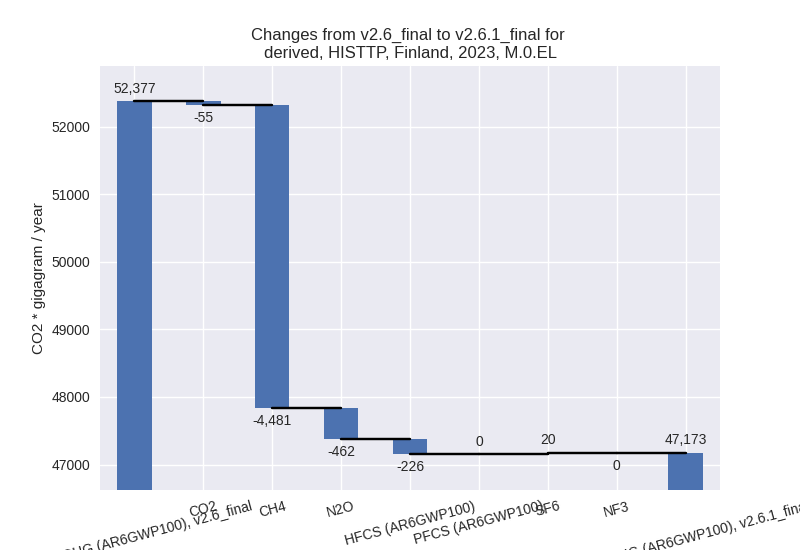
1990-2023
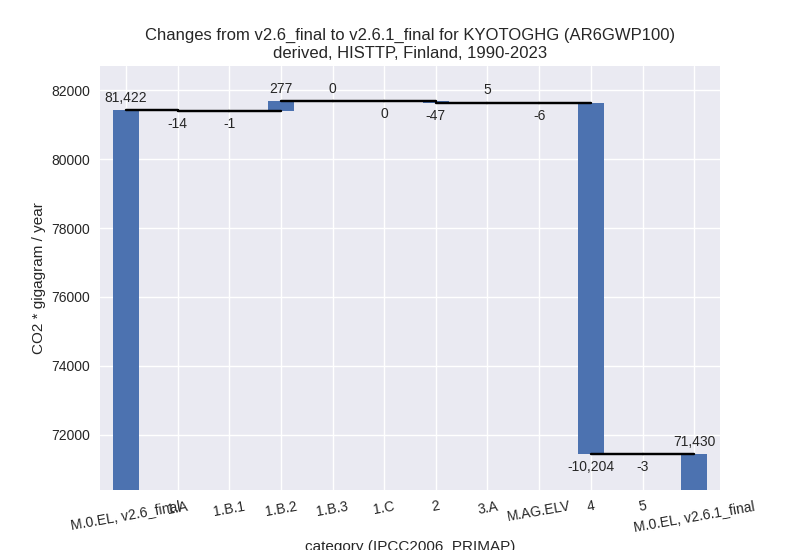
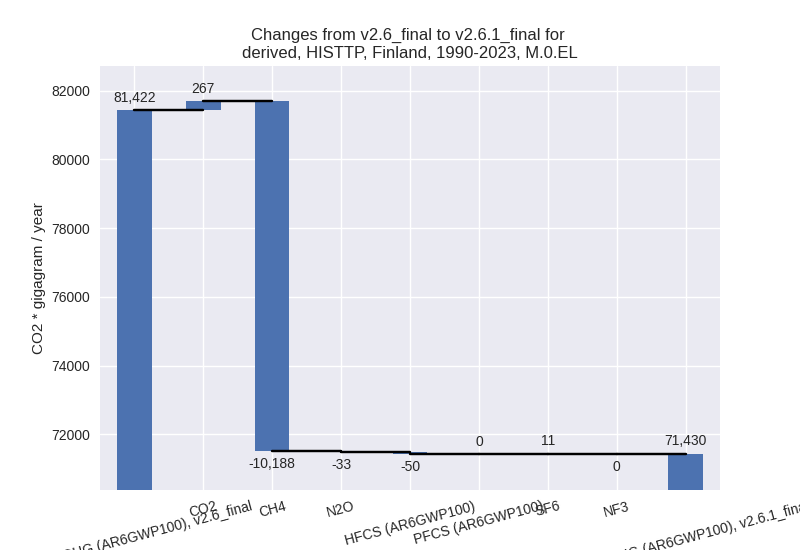
Detailed changes for the scenarios:
country reported scenario (HISTCR):
Most important changes per time frame
For 2023 the following sector-gas combinations have the highest absolute impact on national total KyotoGHG (AR6GWP100) emissions in 2023 (top 5):
- 1: 4, CH4 with -260.17 Gg CO2 / year (-16.5%)
- 2: M.AG.ELV, N2O with -101.22 Gg CO2 / year (-3.2%)
- 3: 1.A, N2O with -46.86 Gg CO2 / year (-9.7%)
- 4: 2, N2O with -40.08 Gg CO2 / year (-19.6%)
- 5: 3.A, CH4 with 16.20 Gg CO2 / year (0.6%)
For 1990-2023 the following sector-gas combinations have the highest absolute impact on national total KyotoGHG (AR6GWP100) emissions in 1990-2023 (top 5):
- 1: 2, HFCS (AR6GWP100) with 16.64 Gg CO2 / year (1.8%)
- 2: 4, CH4 with -7.65 Gg CO2 / year (-0.2%)
- 3: M.AG.ELV, N2O with -2.98 Gg CO2 / year (-0.1%)
- 4: 1.A, N2O with -1.38 Gg CO2 / year (-0.3%)
- 5: 2, N2O with -1.18 Gg CO2 / year (-0.1%)
Changes in the main sectors for aggregate KyotoGHG (AR6GWP100) are
- 1: Total sectoral emissions in 2022 are 32881.57 Gg CO2 / year which is 71.6% of M.0.EL emissions. 2023 Emissions have changed by -0.2% (-43.81 Gg CO2 / year). 1990-2023 Emissions have changed by -0.0% (-1.29 Gg CO2 / year).
- 2: Total sectoral emissions in 2022 are 5130.17 Gg CO2 / year which is 11.2% of M.0.EL emissions. 2023 Emissions have changed by -0.8% (-41.66 Gg CO2 / year). 1990-2023 Emissions have changed by 0.3% (15.26 Gg CO2 / year).
- M.AG: Total sectoral emissions in 2022 are 6161.80 Gg CO2 / year which is 13.4% of M.0.EL emissions. 2023 Emissions have changed by -1.4% (-84.21 Gg CO2 / year). 1990-2023 Emissions have changed by -0.0% (-2.48 Gg CO2 / year).
- 4: Total sectoral emissions in 2022 are 1723.66 Gg
CO2 / year which is 3.8% of M.0.EL emissions. 2023 Emissions have
changed by -15.4% (-257.14 Gg CO2 /
year). 1990-2023 Emissions have changed by -0.2% (-7.56 Gg CO2 / year). For 2023 the
changes per gas
are:
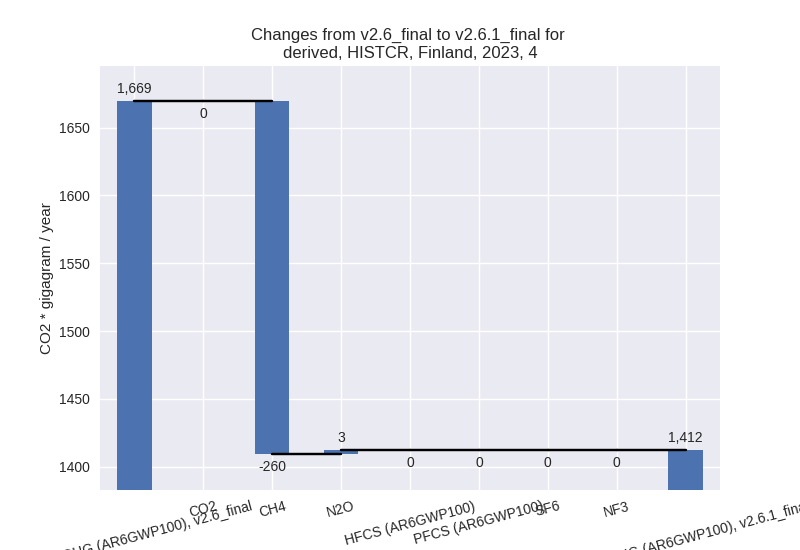
- 5: No data
third party scenario (HISTTP):
Most important changes per time frame
For 2023 the following sector-gas combinations have the highest absolute impact on national total KyotoGHG (AR6GWP100) emissions in 2023 (top 5):
- 1: 4, CH4 with -4546.70 Gg CO2 / year (-65.6%)
- 2: M.AG.ELV, N2O with -334.07 Gg CO2 / year (-7.9%)
- 3: 2, HFCS (AR6GWP100) with -225.99 Gg CO2 / year (-21.1%)
- 4: 2, CO2 with -109.95 Gg CO2 / year (-4.7%)
- 5: 1.A, N2O with -104.50 Gg CO2 / year (-9.1%)
For 1990-2023 the following sector-gas combinations have the highest absolute impact on national total KyotoGHG (AR6GWP100) emissions in 1990-2023 (top 5):
- 1: 4, CH4 with -10204.99 Gg CO2 / year (-67.1%)
- 2: 1.B.2, CO2 with 266.66 Gg CO2 / year (2467.4%)
- 3: 2, HFCS (AR6GWP100) with -50.20 Gg CO2 / year (-5.0%)
- 4: 1.A, N2O with -17.07 Gg CO2 / year (-1.1%)
- 5: 2, SF6 with 11.37 Gg CO2 / year (73.2%)
Changes in the main sectors for aggregate KyotoGHG (AR6GWP100) are
- 1: Total sectoral emissions in 2022 are 38094.24 Gg CO2 / year which is 72.9% of M.0.EL emissions. 2023 Emissions have changed by -0.0% (-3.38 Gg CO2 / year). 1990-2023 Emissions have changed by 0.5% (262.30 Gg CO2 / year).
- 2: Total sectoral emissions in 2022 are 4398.15 Gg
CO2 / year which is 8.4% of M.0.EL emissions. 2023 Emissions have
changed by -7.7% (-350.44 Gg CO2 /
year). 1990-2023 Emissions have changed by -1.1% (-46.76 Gg CO2 / year). For 2023 the
changes per gas
are:
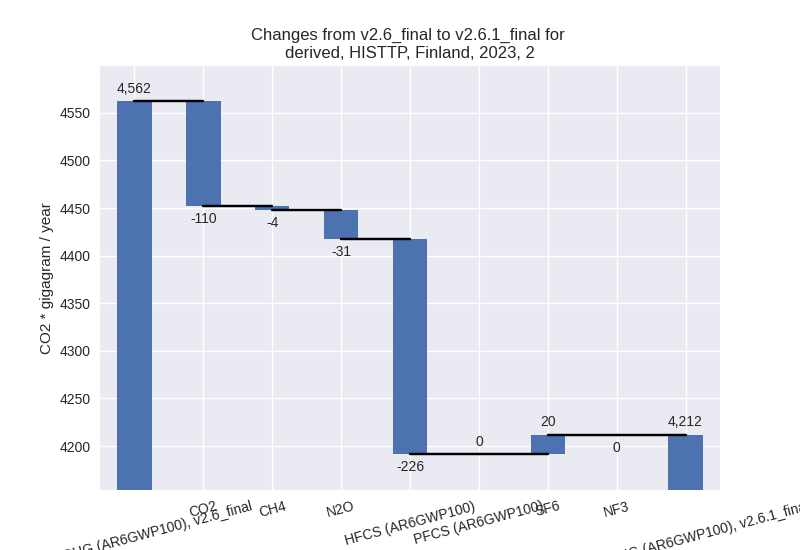
- M.AG: Total sectoral emissions in 2022 are 6424.84
Gg CO2 / year which is 12.3% of M.0.EL emissions. 2023 Emissions have
changed by -4.6% (-306.59 Gg CO2 /
year). 1990-2023 Emissions have changed by -0.0% (-1.21 Gg CO2 / year). For 2023 the
changes per gas
are:
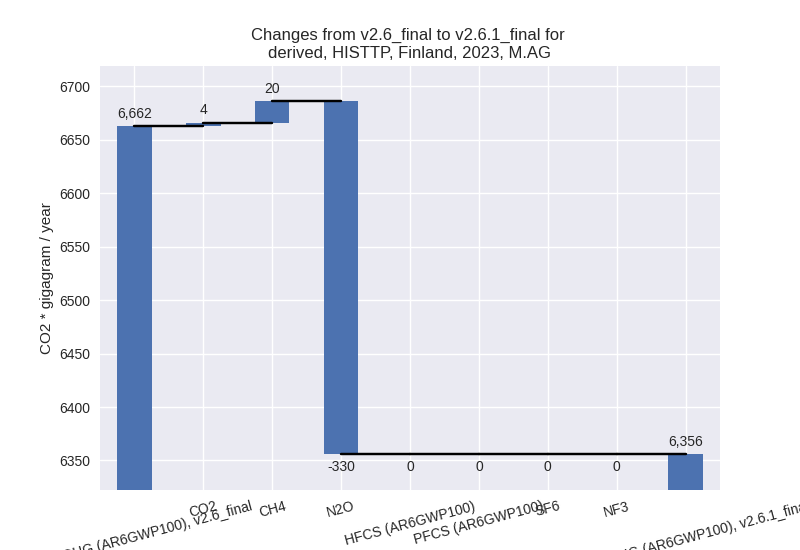
The changes come from the following subsectors:- 3.A: Total sectoral emissions in 2022 are 2442.24 Gg CO2 / year which is 38.0% of category M.AG emissions. 2023 Emissions have changed by 1.1% (26.93 Gg CO2 / year). 1990-2023 Emissions have changed by 0.2% (5.19 Gg CO2 / year).
- M.AG.ELV: Total sectoral emissions in 2022 are
3982.61 Gg CO2 / year which is 62.0% of category M.AG emissions. 2023
Emissions have changed by -7.9%
(-333.52 Gg CO2 / year). 1990-2023 Emissions have changed by -0.2% (-6.40 Gg CO2 / year). For 2023 the
changes per gas
are:
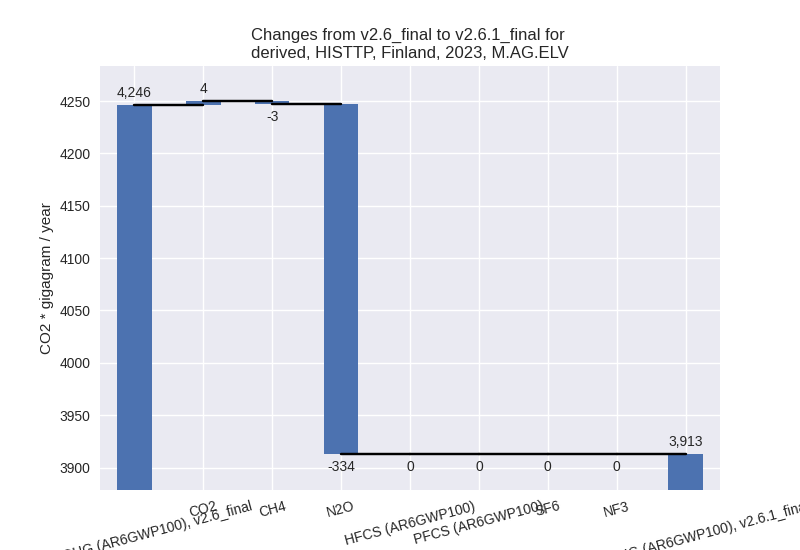
There is no subsector information available in PRIMAP-hist.
- 4: Total sectoral emissions in 2022 are 3135.46 Gg
CO2 / year which is 6.0% of M.0.EL emissions. 2023 Emissions have
changed by -63.9% (-4540.79 Gg CO2 /
year). 1990-2023 Emissions have changed by -66.5% (-10204.35 Gg CO2 / year). For 2023
the changes per gas
are:
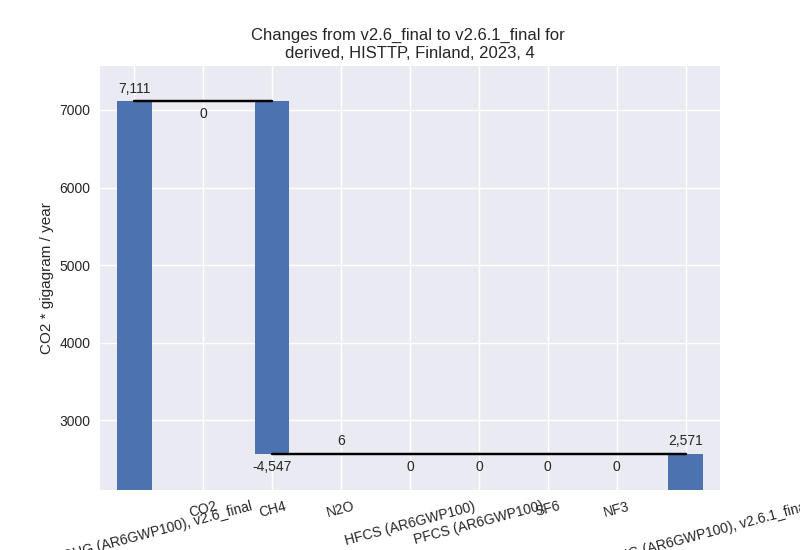
For 1990-2023 the changes per gas are: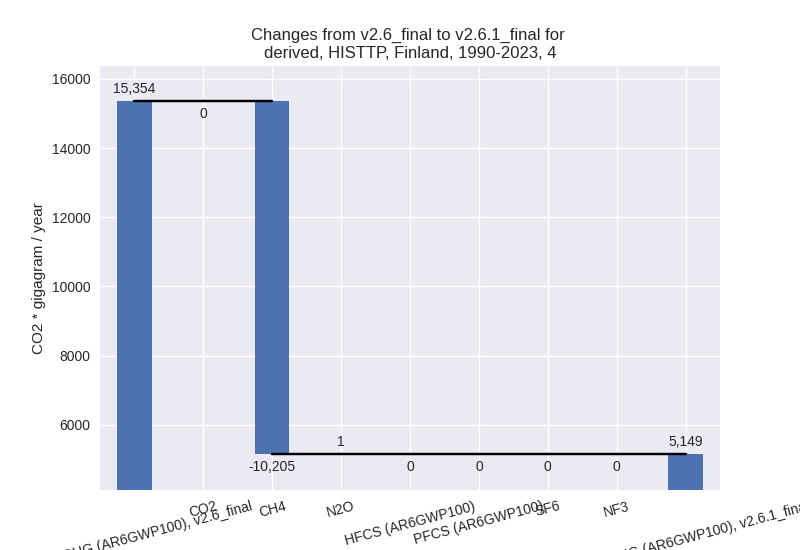
- 5: Total sectoral emissions in 2022 are 229.77 Gg CO2 / year which is 0.4% of M.0.EL emissions. 2023 Emissions have changed by -1.3% (-2.82 Gg CO2 / year). 1990-2023 Emissions have changed by -0.8% (-2.57 Gg CO2 / year).